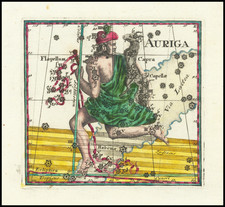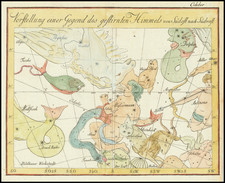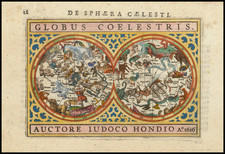Fine pair of images of the phases of the moon, which appeared in Luigi Marsigili's monumental Danubius Pannonico-Mysicus, published in 1726.
The image shows two distinct phases of the Moon as observed in the 17th century. The first image translates to "Phase of the Moon Increasing Gibbous, observed at Sălnița," with the observation made in the year 1696 on the 9th of August around 10 p.m. The depiction shows the Moon in a gibbous phase, which occurs when the Moon is more than half illuminated but not yet full. The detailed features of the lunar surface, including craters and maria (the dark, flat plains), are rendered with great care, reflecting the meticulous nature of scientific observation of the time.
The second image translates to "Phase of the Full Moon, observed at Szeged," with the observation made in 1696 between 10 and 11 p.m. on the 11th of July. This portrayal of the full Moon phase shows the lunar disc completely illuminated, offering a different perspective of the surface features compared to the first image. The contrast between the two phases highlights the dynamic nature of the Moon's appearance as observed from Earth.
Both images originate from Luigi Marsili's "Danubius Pannonico-Mysicus," a comprehensive work published in 1726 that documents the Danube River region's geography, natural history, and culture. Marsili, a polymath and a military officer, was also an avid naturalist and scientist, and his observations of the Moon were part of his broader scientific studies.
These images are a window into the scientific practices of the late 17th century, illustrating the painstaking work of astronomers who relied on direct observation and artistic representation to document and share their findings. The enduring value of such historical scientific documents lies in their ability to convey the knowledge and methods of past scholars, providing insights into the evolution of scientific understanding over time.
Count Luigi Ferdinando Marsigli (1658–1730) was a distinguished Italian scholar, renowned natural scientist, and soldier. Born into a noble family in Bologna, Marsigli was educated in mathematics, anatomy, and natural history.
Marsigli's intellectual pursuits took him across Asia Minor, where he meticulously collected data on the Ottoman Empire's military organization and natural history. This expedition was not just an academic endeavor; it also marked the beginning of his military career. In 1682, Marsigli entered the service of Emperor Leopold and soon distinguished himself in battles against the Turks. He was wounded and captured on the River Rába. Following his release in 1684, Marsigli returned to the Imperial Army, contributing significantly to the siege of Buda in 1686 and the subsequent liberation war against the Turks.
. After the Treaty of Karlowitz, Marsigli was appointed to lead the Habsburg border demarcation commission. During this time, he accumulated a wealth of scientific data and specimens, laying the groundwork for his future scholarly publications.
During the War of the Spanish Succession, he faced disgrace after the fall of the Imperial fortress of Breisach. However, Marsigli continued his scientific explorations, traveling to Switzerland and France, where he conducted extensive studies on various natural phenomena.
In 1712, Marsigli returned to Bologna, where he generously donated his extensive collection of specimens and data to the University of Bologna, which led to the establishment of the "Institute of Sciences and Arts," which he founded and opened formally in 1715. The institute, under his guidance, became a hub of scientific learning, equipped with a printing house for publishing scholarly works in multiple languages.
Marsigli's legacy in the scientific community is immense. His major work, "Danubius Pannonico-Mysicus," published in 6 volumes in 1726, is a testament to his dedication and meticulous approach to scientific inquiry. This work, along with his treatise on oceans published in 1725, earned him recognition as a pioneer of modern oceanography. His scholarly impact was acknowledged through his associations with prestigious institutions like the Royal Society of London and the Paris Academy of Sciences.
Marsigli's extensive bibliography, which includes over twenty works, reflects the breadth of his interests and contributions. Among his notable publications are "Osservazioni interne al Bosforo Tracio" (1681), "Histoire physique de la mer" (1725), and the six-volume "Danubius Pannonico-Mysicus" (1726). These works, rich in historical and scientific content, remain valuable resources for understanding the natural and military history of his time.









![[ Lyra ] (Stars Heightened in Gold)](https://storage.googleapis.com/raremaps/img/small/83179.jpg)

![[Taurus, Cancer, Orion, Gemini, Monoceros, Argo, Hydra, Canis Major, Lepus]](https://storage.googleapis.com/raremaps/img/small/98296.jpg)
![[ Orion / Canis Minor / Lepus ]](https://storage.googleapis.com/raremaps/img/small/102620.jpg)

